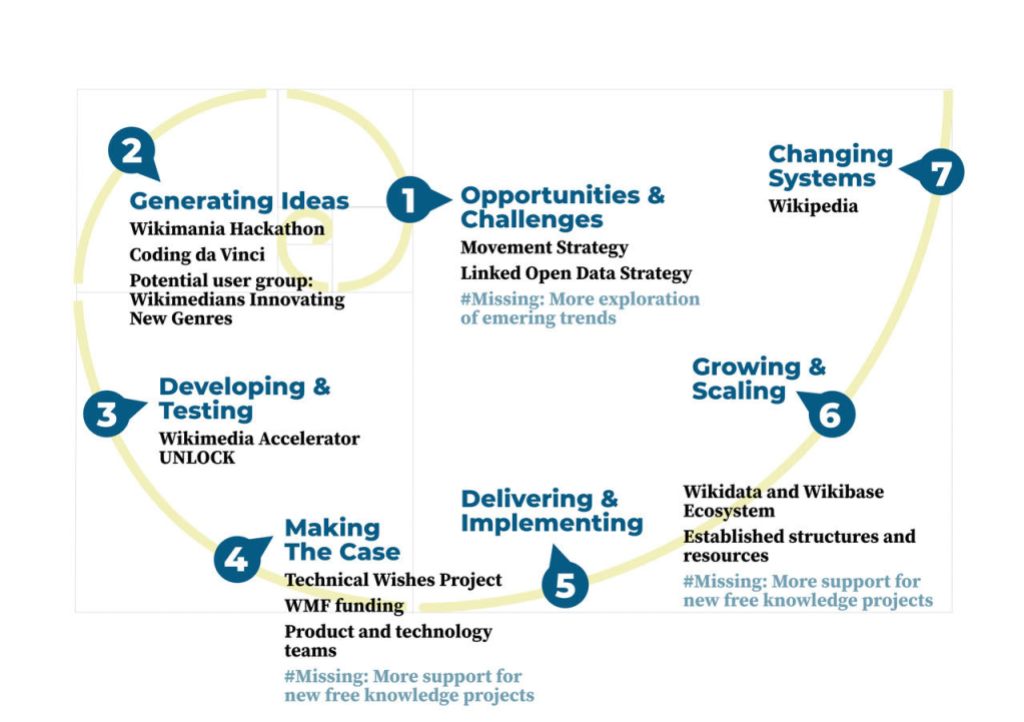With a clear and bold vision, with concrete recommendations and guiding principles in ‘our bag’, the Wikimedia Movement Strategy is undergoing implementation. Recommendation 9 “Innovate in Free Knowledge” specifically calls for the exploration and expansion of free knowledge projects. Strengthening the innovative capacity of the movement will be key to address gaps in knowledge equity, and therefore, to stay relevant and attractive as a movement in the future. But how to ‘innovate in free knowledge’?
Building upon this recommendation, our team at Wikimedia Deutschland developed a paper that provides a first overview on where we are at in terms of innovation; how innovation is currently being promoted in the movement; what structures, programs, and resources are already in place, and which are still missing.
Building an ecosystem to innovate in free knowledge
What will be Wikimedia’s next systemic innovation that fundamentally changes how human knowledge is produced, made accessible and shared? Driving innovation means that we must take a more systematic approach in order to not only set selective and short-term impulses for innovation, but to create a long-term, sustainable impact with different actors and stakeholders as well as our actions. For this, we need: an open mindset towards change and innovation; the courage to experiment, fail and continuously learn; a movement-wide commitment to recommendation 9; resources to expand the innovation stages and build an innovation ecosystem; and involvement of movement stakeholders and of other mission-aligned organizations across all stages of innovation.
Mapping what initiatives, processes and structures already exist
There are different stages of innovation – taking into account the different structures, people, processes of support that innovators and innovations might require at each stage in order to grow. The paper maps out how each innovation stage is or isn’t existent within our movement. It’s not surprising to see structures and processes in place to support the development of existing Wikimedia projects. For instance, ideas are generated and challenges tackled at the Wikimania Hackathon. Validated ideas and prototypes that are related to existing Wikimedia projects can be more easily integrated into the existing ecosystem (if all requirements are met) due to structures that are already in place: dedicated product and technology teams, funding and other community-driven approaches that can take up prototypes, develop them further or accompany them in their further development and thus integrate them into the existing ecosystem. This can be seen in the Technical Wishes Project, in the development of Wikidata or Wikibase Ecosystem.
The paper also uncovers what is still clearly lacking: there are only few support structures and resources to promote new free knowledge projects that are equally needed for the movement to evolve, grow and to become sustainable. Among those few is for instance the Wikimedia Accelerator UNLOCK, – an innovation-driving program that aims to promote new free knowledge ideas and solutions.
The outlined examples are far from exhaustive, so don’t see this as the final and absolute version of the mapping. This map is one way to raise awareness and make ‘innovate in free knowledge’ become more relevant in our movement. Please have a look, and leave your comments and/or questions on the talk page. We are more than happy to engage in conversations and eager to hear additional perspectives, insights, and feedback from across the movement related to this topic. Please also reach out to me directly to explore ways to take the conversation forward.

Can you help us translate this article?
In order for this article to reach as many people as possible we would like your help. Can you translate this article to get the message out?
Start translation
